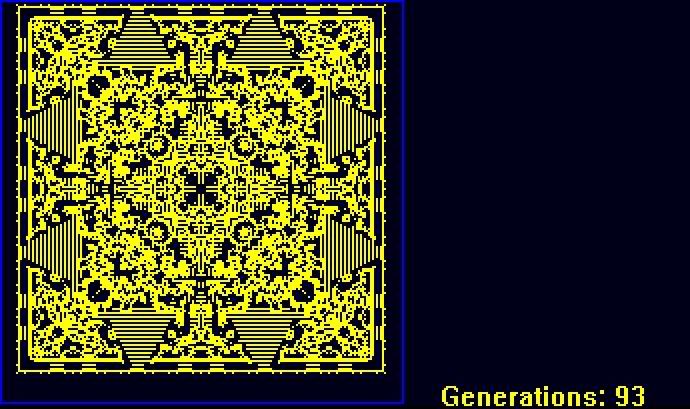I saw this video of
Will Wright's cellular autonomy program and I've started making my own.
Here's a cool Java applet I found of
Conway's game of life. This is one of the rule sets that can be applied to this type of program.
Here's what I have so far:
remstart
--------
Functions
* _border() - draws a border around the grid
--------
Notes
* Make rules adjustable in editor
* Make zoom function
* Enable editing mid-sequence
remend
set emulation off
hide mouse
sync on : sync rate 60
pmax=200
DIM pixel(pmax+1,pmax+1)
DIM pixelBuff(pmax+1,pmax+1)
DIM color(1)
color(1) = rgb(255,255,0)
gen=0
`Make Cursor
ink 65536*255,0
dot 1,0
dot 0,1
dot 1,2
dot 2,1
get image 1,0,0,3,3
cls 0
`-------------------------------
` EDITOR
`-------------------------------
rem - use the editor to experiment with different start images
Repeat
gosub _border
sprite 1,mousex()-1,mousey()-1,1
if mouseclick()>0
click = mouseclick() : if click>1 then click=0
mx=mousex() : my=mousey()
if mx>0 and my>0 and mx<pmax+1 and my<pmax+1
pixel(mx,my)= click
ink color(pixel(mx,my)),0
dot mx,my
endif
endif
sync
Until returnkey()=1
`-------------------------------
` MAIN LOOP
`-------------------------------
sync rate 0
hide sprite 1
DO
ink 30,0 : box 0,0,pmax+150,pmax+2
gosub _border
For y = 1 to pmax
for x = 1 to pmax
neighbours = 0
if pixel(x,y)=1 then dec neighbours : `remove selected pixel from equation
for oy = -1 to 1
for ox = -1 to 1
if pixel(x+ox,y+oy)=1 then inc neighbours
next ox
next oy
`Apply Rules
REMSTART
* Conway's rule set
For a space that is 'populated':
Each cell with one or no neighbors dies, as if by loneliness.
Each cell with four or more neighbors dies, as if by overpopulation.
Each cell with two or three neighbors survives.
For a space that is 'empty' or 'unpopulated'
Each cell with three neighbors becomes populated.
---
* Rule Types
=0 : cell is now dead
=1 : cell is now alive
=pixel(x,y) : status of the cell stays the same
=1-pixel(x,y) : a dead cell becomes live; a live one becomes dead
REMEND
Select neighbours
case 0 : pixelBuff(x,y)=0 : endcase
case 1 : pixelBuff(x,y)=0 : endcase
case 2 : pixelBuff(x,y)=pixel(x,y) : endcase
case 3 : pixelBuff(x,y)=1 : endcase
case 4 : pixelBuff(x,y)=0 : endcase
case 5 : pixelBuff(x,y)=0 : endcase
case 6 : pixelBuff(x,y)=0 : endcase
case 7 : pixelBuff(x,y)=0 : endcase
case 8 : pixelBuff(x,y)=0 : endcase
Endselect
if pixel(x,y)>0
ink color(pixel(x,y)),0
dot x,y
endif
next x
next y
for y = 1 to pmax
for x = 1 to pmax
pixel(x,y) = pixelBuff(x,y)
next x
next y
inc gen,1
ink color(1),0
set cursor pmax+20,pmax-10
print "Generations: "; gen
wait 20
sync
LOOP
`-------------------------------
` GOSUBS
`-------------------------------
_border:
ink 255,0
l=0 : t=0 : r=pmax+1 : b=pmax+1
line l,t,r,t : line r,t,r,b : line r,b,l,b : line l,b,l,t
RETURN
When you run it you are in editor mode, left click to add "live" pixels and right click to remove. Press return when you want to begin.
Here are the Conway rules to help you with your design.
For a space that is 'populated':
Each cell with one or no neighbors dies, as if by loneliness.
Each cell with four or more neighbors dies, as if by overpopulation.
Each cell with two or three neighbors survives.
For a space that is 'empty' or 'unpopulated'
Each cell with three neighbors becomes populated.
I am basically looking for advice on how to turn this into a full program with a TDK style interface.
Here's my best one so far

Here's an intricate pattern using another rule set. This started as a single cell!!

!